Tim Hodkinson's Blog
April 11, 2024
Wodnas
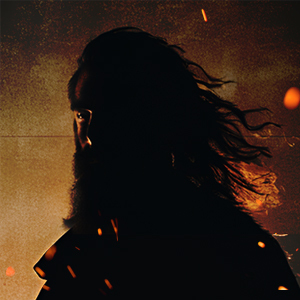
My new novel, Sword of the War God, is out in hardback today (April 11). It is historical fiction set in the early half of the Fifth Century AD. This was a truly fascinating time: The Saxons began crossing the sea to Britain, the Roman Empire was on its last legs, struggling to survive against waves of barbarian invasions, the Huns came from the East. Legendary figures such as King Arthur or Saint Patrick, if they existed, lived through all this, as well as others like Atilla, Guðrún and Gunnar, Sigurd the dragon slayer and many others. Their adventures inspired Old Norse Sagas like Saga of the Völsungs, the medieval German epic The Nibelungenlied and modern works from the operas of Richard Wagner to Tolkien’s Lord of the Rings.
Sword of the War God takes those legends and places them back into the historical context in which they happened.
Over the launch, I am posting short intros to the main characters here, covering their role in the book and their historical or legendary (and sometimes both) inspirations. So far we covered Sigurd, Hagan, Brunhild. First was the “Little Daddy”, Atilla. Today it is the turn of the All Father, Wodnas.
Wodnas in Sword of the War God was once king of Asaland, Wodnas used his guile, wisdom and inspirational spirit to hold off the Huns for many years. Finally their superior numbers overcame his kingdom. He became a landless wanderer, leading the remnants of his folk in search of a new home, always keen to help enemies of the Huns.
Tall, thin and one-eyed, Wodnas walks barefoot, using a spear as a walking stick. His deep knowledge and strange manners make many think he is a wizard.
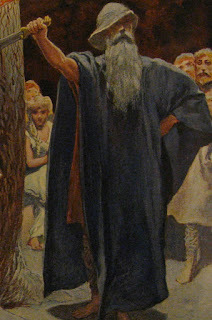
“Wodnas” is the oldest form we have written evidence for of the name of the Norse God better known today as Odin. It was stamped in runes on a bracteate (a sort of medallion) dating to the fifth century, co-incidentally the same time Sword of the War God is set. This makes sense when you consider the day of the week the Anglo-Saxons named after him around that time: Wednesday.
See here for more on the Neil Gaiman character of Mr Wednesday and his links to Odin.
The character of Odin is a compelling one: A wise wanderer, a trickster and liar yet guardian of order against chaos, a worker of magic, a god of storm and frenzy who inspires both poetry and the homicidal rage of the berserker. Carl Jung in his infamous essay on Wotan (the German name for Odin) identified Odin as an archetypal figure who resides in the heart of people at the primordial level, and when a politician manages to tap into that the results can be devastating.
It was 13th Century Icelandic poet, politician and historian Snorri Sturlusson who wrote that Odin was in fact a king who ruled a kingdom near the river Don in what is now southern Ukraine Extremely wise, inspirational in battle and skilled in warfare, when he died he was such a great ruler remembrance of him turned to worship as a god.
So is he a god, a wizard or just wiser and more learned that those around him? As Arthur C Clarke wrote: “Any sufficiently advanced technology is indistinguishable from magic”, but I will leave the reader to decide.
April 10, 2024
Sigurd the Dragon Slayer
My new novel, Sword of the War God, is out in hardback on April 11. It is historical fiction set in the early half of the Fifth Century AD. This was a truly fascinating time: The Saxons began crossing the sea to Britain, the Roman Empire was on its last legs, struggling to survive against waves of barbarian invasions, the Huns came from the East. Legendary figures such as King Arthur or Saint Patrick, if they existed, lived through all this, as well as others like Atilla, Guðrún and Gunnar, Sigurd the dragon slayer and many others. Their adventures inspired Old Norse Sagas like Saga of the Völsungs, the medieval German epic The Nibelungenlied and modern works from the operas of Richard Wagner to Tolkien’s Lord of the Rings.
Sword of the War God takes those legends and places them back into the historical context in which they happened.
In the run up to the launch, I am posting short intros to the main characters here, covering their role in the book and their historical or legendary (and sometimes both) inspirations. So far we've covered Hagan,Brunhild and the “Little Daddy” himself, Atilla. Today it is the turn of the larger than life, Sigurd.
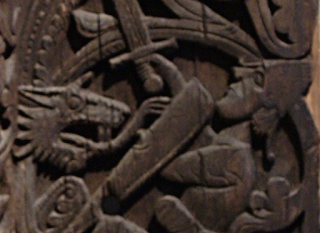
Sigurd (Sigurð) is a hero: A giant of a man, a superb warrior with invincible armour. He is also an arrogant, self seeking bully. He wants to marry the world’s most beautiful woman, Gunhild. He wants to be king. He wants more gold than everyone else. A member of the Volsung clan of the Burgundar people, though not born into the upper nobility, Sigurd carries that chip on his shoulder which drives him to achieve so much, yet also is his downfall.
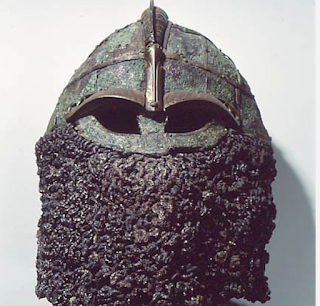
A central figure in Germanic mythology, Sigurd the Dragon Slayer (or Siegfried as he is also known) has a central role in all the ancient myths, legends or artistic creations that have grown up around these historic events. He appears in Old Norse poetry and prose (Volsunga saga, Þiðreks saga and numerous others), medieval works like the Nibelungenlied or more modern works like Richard Wagner's opera Ring of the Nibelung or William Morris’ Story of Sigurd the Volsung and the Fall of the Niblungs. My portrayal of him came from me wanting to explore the idea that heroes are heroes because they do things the rest of us are too scared to. However the personality traits that allow them to do those deeds often also make them unpleasant people to be around.
I once played for a rugby club where one of the former members was an Irish international and also a hero of World War Two. The man was literally a legend with books written about him, TV shows and a statue erected to him in town. However none of the old timers in the club who actually knew him had a good word to say about him. The saying that “one side’s hero is the other side’s psychopathic killer” seems apt. Sigurd’s segmented Byzantine armour in the book is a nod towards the legend that when he killed the dragon Fafnir he bathed in Fafnir’s blood which rendered his skin invulnerable to weapons. However a leaf was stuck to him leaving one patch of his back normal, and it is through that he was eventually killed.As I write historical fiction not fantasy, having an actual dragon in the tale was not possible. However when research told me the late Roman army had troopers known as dragons, and companies bore dragon banners, the solution was obvious for how Sigurd, a warrior fighting against the Empire, could have got his nickname of dragon slayer.
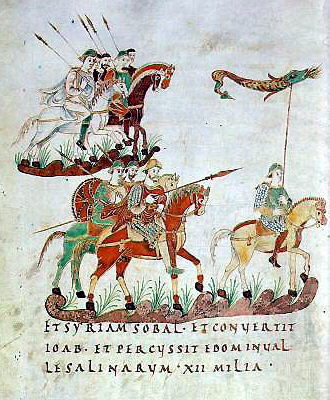
April 8, 2024
Hagan
My new novel, Sword of the War God, is out in hardback on April 11. It is historical fiction set in the early half of the Fifth Century AD. This was a truly fascinating time: The Saxons began crossing the sea to Britain, the Roman Empire was on its last legs, struggling to survive against waves of barbarian invasions, the Huns came from the East. Legendary figures such as King Arthur or Saint Patrick, if they existed, lived through all this, as well as others like Atilla, Guðrún and Gunnar, Sigurd the dragon slayer and many others. Their adventures inspired Old Norse Sagas like Saga of the Völsungs, the medieval German epic The Nibelungenlied and modern works from the operas of Richard Wagner to Tolkien’s Lord of the Rings.
Sword of the War God takes those legends and places them back into the historical context in which they happened.
In the run up to the launch, I am posting short intros to the main characters here, covering their role in the book and their historical or legendary (and sometimes both) inspirations. Yesterday was the turn of Brunhild and the day was the “Little Daddy” himself, Atilla. Today it is the turn of the main character around who all the events of the tale revolve: Hagan.

Hagan, Gunhild and Gunderic and Brunhild grew up together as childhood friends. Through his young life Hagan believed he was the son of the foremost champion of his tribe, the Burgundars, only to learn that in fact his mother was raped by an unknown assailant and he is the bastard offspring. Soon after that he loses everything else - home, friends, people - and becomes first a Roman army conscript then a wandering mercenary. Lonely though never morose, Hagan has a special talent for stealth and hunting. He is the central character of the tale.
Sometimes good, sometimes epitomising tradition or common sense, sometimes a force for evil, Hagan (also called Hogni) appears in all the tales and myths associated with this legend. My portrayal of him was inspired by an Old English poem now known as The Wanderer, a melancholy elegy about a warrior who has lost everything he held dear and now wanders the earth alone, enduring its hardships.
Hagan is neither good nor bad. He tries to act for the best but has no control over the consequences of his actions.
Hwær cwom mearg? Hwær cwom mago? Where is the horse gone? Where the rider?
Hwær cwom maþþumgyfa? Where the giver of treasure?
Hwær cwom symbla gesetu? Where are the seats at the feast?
Hwær sindon seledreamas? Where are the revels in the hall?
Eala beorht bune! Alas for the bright cup!
Eala byrnwiga! Alas for the mailed warrior!
Eala þeodnes þrym! Alas for the splendour of the prince!
Hu seo þrag gewat, How that time has passed away,
genap under nihthelm, dark under the cover of night,
swa heo no wære. as if it had never been!
-from The Wanderer
April 7, 2024
Brynhild - chooser of the slain
My new novel, Sword of the War God, is out in hardback on April 11. It is historical fiction set in the early half of the Fifth Century AD. This was a truly fascinating time: The Saxons began crossing the sea to Britain, the Roman Empire was on its last legs, struggling to survive against waves of barbarian invasions, the Huns came from the East. Legendary figures such as King Arthur or Saint Patrick, if they existed, lived through all this, as well as others like Atilla, Guðrún and Gunnar, Sigurd the dragon slayer and many others. Their adventures inspired Old Norse Sagas like Saga of the Völsungs, the medieval German epic The Nibelungenlied and modern works from the operas of Richard Wagner to Tolkien’s Lord of the Rings.
Sword of the War God takes those legends and places them back into the historical context in which they happened.
In the run up to the launch, I am posting short intros to the main characters here, covering their role in the book and their historical or legendary (and sometimes both) inspirations. Yesterday was the turn of the “Little Daddy” himself, Atilla. Today it is the turn of Brynhild.

In Sword of the War God, Brynhild was one of the four Burgundar friends who grew up around Vorbetomagus (along with Hagan, Gunhild and Gunderic) until the Romans and Huns came. She was once one of the Swan Maidens, a secretive religious order. With the destruction of the Burgundars, and rape and murder of most of her sister Swan Maidens, Brunhild escapes to create her own new order of women, this time a military one, the Valkyrjur. Strong and independent though mentally wounded by the violence she has suffered, after being tricked into marrying Gunderic then terribly assaulted, Brynhild wrecks a bloody vengence.
Brynhild is of course inspired by the legendary figure of Brunhild the valkyrie who appears in everything from norse myths to Wagnerian opera to being the inspiration for the name of an asteroid. The tragic love triangle between Brynhild/Brunhild, Gunhild and Sigurd sits at the heart of the saga of the Volsungs, the Nibelungenlied and many of the other myths and legends associated with these events. In these myths Brunhild is described as a valkyrie, a kind of supernatural woman in old norse tradition associated with Odin. Valkyries/valkyrur means “Choosers of the slain”. Brunhild is a problematic character who in the lore brings about the death of Sigurd, then unable to live with the deed commits suicide. An old norse poem - Helreið Brynhildar, Brunhild’s Hell Ride - recounts her subsequent journey to the otherworld.
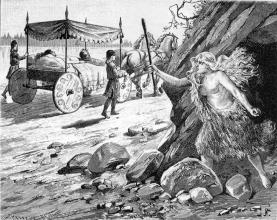
The charge of Thorismund and his visigoth cavalry down the ridge to turn the tide of battle at the Catelaunian Fields described in the novel was a real historical event. The Osprey non-fiction book about the battle identifies the location of the fields and the ridge as just outside Troyes in modern France. To this day the area at the foot of the ridge there is called “l’Enfer”, or “Hell”. Therefore it seemed appropriate to add in my novel the ride of the valkyries alongside the Visigoth troopers, led by Brynhild into Hell.
April 5, 2024
Atilla the Hun
Yesterday I posted about my new novel, which is out on April 11. The book is historical fiction set in the early half of the Fifth Century AD. This was a truly fascinating time: The Saxons began crossing the sea to Britain, the Roman Empire was on its last legs, struggling to survive against waves of barbarian invasions, the Huns came from the East. Legendary figures such as King Arthur or Saint Patrick, if they existed, lived through all this, as well as others like Atilla, Guðrún and Gunnar, Sigurd the dragon slayer and many others. Their adventures inspired Old Norse Sagas like Saga of the Völsungs, the medieval German epic The Nibelungenlied and modern works from the operas of Richard Wagner to Tolkien’s Lord of the Rings.
Sword of the War God takes those legends and places them back into the historical context in which they happened.
Over the next few days I will post short introductions to the main characters, starting with the “Little Daddy” himself, Atilla the Hun.
 AtillaKing of the Huns, Atilla grew up in a warrior culture where mercy was a sign of weakness and life was a brutal game of survival of the most ruthless, even when your rivals were your own flesh and blood. He and his brother were joint kings of the Huns, a restless people with an empire that was expanding as fast as their horses could ride. The Huns had two rulers so as to stop one king ever getting above himself and going mad with power. Employed by the Romans as mercenaries, the Huns are quick to see the decadent, rotting facade the Empire has become. All it would take are a few heavy blows to bring it to the ground. Atilla wants the world and when the Roman Emperor’s sister offers herself to him as his bride, he has the justification to take it.
AtillaKing of the Huns, Atilla grew up in a warrior culture where mercy was a sign of weakness and life was a brutal game of survival of the most ruthless, even when your rivals were your own flesh and blood. He and his brother were joint kings of the Huns, a restless people with an empire that was expanding as fast as their horses could ride. The Huns had two rulers so as to stop one king ever getting above himself and going mad with power. Employed by the Romans as mercenaries, the Huns are quick to see the decadent, rotting facade the Empire has become. All it would take are a few heavy blows to bring it to the ground. Atilla wants the world and when the Roman Emperor’s sister offers herself to him as his bride, he has the justification to take it.

Bleda, Atilla’s brother and fellow King of the Huns, disagrees. He thinks they should first milk the Empire dry, and after all he is the elder brother. Atilla is not the sort of man who would let that sort of thing get in the way, however. If he were sole king of the Huns he would not have to worry what Bleda thought…
Atilla’s name means “Little Daddy”, a clue perhaps to the sort of man he was, or what might have driven him in his endless quest to be king of the world or to have the most beautiful woman in the world as his wife. The Burgundar tribe possess a fabulous treasure, the Rhine Gold, said to be worth half the wealth of a kingdom. Atilla wants that too.
And then there is the Sword of the War God, the magical weapon that shows Devine approval of however bears it as king of the Huns. Atilla wants that more than everything. The only problem is, it disappeared, stolen during a Burgundar ambush of a previous king of the Huns on the banks of the Rhine.
You can read more about the historical Atilla here: https://en.wikipedia.org/wiki/Attila Tomorrow I'll post about another character from the book.
April 4, 2024
Sword of the War God - Out on April 11
My tenth novel, and first hardback, will be published on April 11. Sword of the War God is a bit of a departure from my usual vikings. Its an epic tale (608 pages) set in a truly legendary age, the early half of the Fifth Century AD. The Roman Empire is tottering on its last legs. A new threat has emerged: the Huns, led by their charismatic and brutal king, Atilla, sweep into Europe burning and massacring all in their path. Caught in the middle of this titanic conflict, a small Germanic tribe, the Burgundars, battles for survival in a war in which both protagonists seem intent on wiping them out. At the time of their greatest danger, a small band of strangers led by a strange, one-eyed wizard, each of them armed with a unique talent, arrive from the east to help.
The Fifth Century was a time of legends. The historical events of those few decades have led to a slew of myths, legends and tales we still tell today. If they existed, the real personages of the folk we now know as King Arthur, Saint Patrick, Sigurd the Dragon Slayer, Brunhild the valkyrie and the Nibelungs with their cursed treasure, the Rhine Gold, lived their lives a this time.
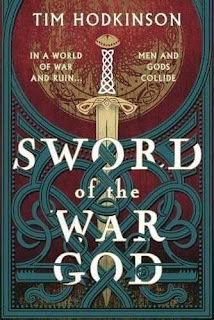
George RR Martin took real history (the Wars of the Roses) and put it into a fantasy setting. In Sword of the War God I have tried to do the opposite: To take the legends which grew out of real events and try to place them back into the historical context in which they happened.
Over the next few days I plan to post short introductions to the characters in the book and the legends that inspired them.
In the meantime you can order your copy from all good retailers:
https://www.amazon.co.uk/Sword-War-God-Tim-Hodkinson/dp/1804540609https://www.bloomsbury.com/us/sword-of-the-war-god-9781804540602/
October 31, 2022
Who was Crom?
Here used to stand a lofty idol, that caused many a fight.Its name was the Crom Cruach; Its caused every tribe to live without peace.He was their God, old wizened Crom, hidden by many mists.And for the folk who believed in him, the eternal Kingdom of Heaven shall never be theirs.For Him they ingloriously slew their firstborn babies, with much wailing and peril, and poured their blood round Crom Cruach.- Mag Slecht
A new, rewritten version of The Spear of Crom will be published by Ares/Head of Zeus on November 10. The date is a coincidence, but quite appropriate. Up until Saint Patrick arrived in Ireland in the 5th Century, at this time of year we would have been preparing to sacrifice our first born children to the old God, Crom.
Old Crom has largely been forgotten in recent years. Crom? Isn’t he Conan the Barbarian’s God? - accompanied by a scoff - was the reaction many of the serious historical fictionados to mention of him; The implication being that sword and sandal fantasy has no place in “real” historical fiction.
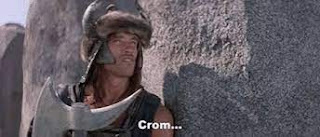
The more discerning may remember Crom as the Maggot God who opposed Slaine MacRoth in the epic 200AD comic series back in the 1980s and 90s. However Crom was an actual Irish deity borrowed by Robert E. Howard for his own mythos.
It may surprise some that unlike a lot of the Celtic deities who modern day pagans will rhyme off from the many internet pages about them (the Dagda, Lugh the Long Armed, Bridget etc.), the surviving evidence we have for Crom comes from much older sources than an of the others, so could well be seen to be more authentic.
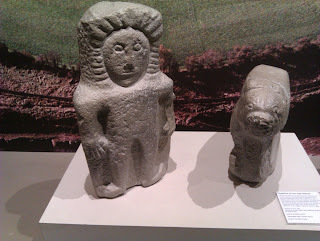 Irish Pagan Gods - Ulster Museum
Irish Pagan Gods - Ulster MuseumSo who was Crom?
Two characters appear in early medieval Gaelic writings who go by the name: Cromm Crúaich and Crom Dubh. The current consensus appears to be that they were the same entity. Crom might mean bent or stooped, thunder or even head or chief. Cruaich is a mound, stack or heap, usually of grain or hay - a harvest - but also a mound of corpses after a battle, the sort of the way “mowing down” and “aftermath” in English have become associated with war. So the “Chief of the Harvests” could be one way to look at his name.
Dubh means black, which sort of shows how his reputation changed as he slipped into Christian memory. Though, if some of the legends are true about how we used to worship him, then he could well be seen as a very dark deity.
The Tripartite Life of Saint Patrick from the 9th Century mentions Crom in the form of a statue covered with gold and silver and surrounded by twelve other bronze figures. Patrick approaches it and raises his crozier, at which the statue of Crom falls down face-forward and the surrounding figures all sink into the earth. A demon, the pagan spirit who inhabited the stone, appears and Patrick curses him off to Hell. The imprint of Patrick’s crozier remains in the stone.
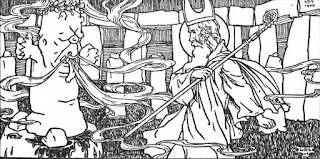
The same story, with the stone imprinted by the crozier, is repeated in another life of Saint Patrick, this time from the 12th Century.
The Dindsenchas (“Lore of places”) go into more detail and it’s from there that the poem at the start of this piece comes from. The Annals of the Four Masters tell the same tale, which was that there was a festival at that this time of year which honoured Crom at a gathering in Magh Slécht, which is in modern county Cavan.
Our modern-day Halloween is the descendant of an important pagan festival called Samhain that preceded it and which shares many of the associated elements of darkness, fear and the supernatural. Samhain was one of the quarter-days of the year celebrated by the ancient people of Ireland. A word very close to Samhain appears on the 2nd Century AD Coligny Calendar, suggesting that Celtic cousins in Europe celebrated the festival too. It was the celtic new year when the old year died and (hopefully) the new year was born. There are lots of references in Early Irish Literature to great clan gatherings and festivals being held at this time of year, and the adventures of heroes and kings that take place at them seem to revolve around a lot of drinking and either the dead or evil fairies coming back from the otherworld to wreck some form of havoc.

According to the lore, ever since the time of King Érimón (sometime around 1700–1684 BC), folk gathered at Magh Slécht in Cavan at Samhain to worship Crom. Crom was represented by gold statue surrounded by twelve other stone figures and was propitiated with the sacrifice of first-born children. In return, Crom would guarantee a good harvest the next year.
At the mention of human sacrifice, people often start to get a bit uneasy and it can be common to blame biased Christian sources for trying to blacken the previous religion’s name. However when we look around the other cultures that existed at the time, it would be more unusual if the ancient Irish didn’t engage in the practice than if they did. We have, after all, quite literally found the bodies.
Bog bodies (of which there are many Irish examples) exhibit such a degree of overkill that it points to some form of ritual, the only alternative being that for centuries psychopathic killers across northern Europe dispatched their victims using remarkably similar methods. Classical writers like Julius Caesar (again admittedly biased against the non-Roman Celts) all attest that the Druids sacrificed people to their Gods. As someone who grew up in Northern Ireland in the 1980s, the idea that the idea that Irish people would kill other Irish people for religious reasons isn’t exactly beyond the pale.
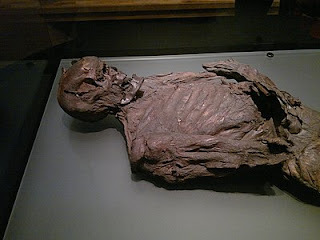 Gallagh Man bog body
Gallagh Man bog bodyIn the Annals of the four Masters, Saint Patrick uses a more practical sledgehammer to break the idol and this is where myth and legend starts to merge with archaeology.
The Killycluggin Stone was found near the town of Killycluggin, County Cavan, in the area that once was Magh Slécht. It is cone-shaped and covered in Iron Age La Tène carvings. When it was discovered it was broken into two pieces and had been buried near to a stone circle where it may have originally stood inside.
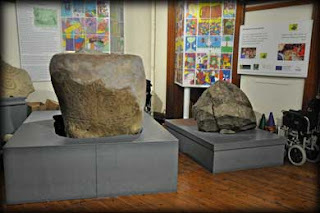 The Killycluggin Stone, Cavan County Museum
The Killycluggin Stone, Cavan County MuseumSo in summary what do we know about Crom? Well it looks like he was worshipped in ancient Ireland, particularly in the north west. He was associated with standing stones - an ancient name for a ring of standing stones was a “cromlech”- and his worship included human sacrifice carried out at Samhain. It’s easy to see how the terror and horror instilled by what went on that night could still echo in the modern Halloween.
The new version of Spear of Crom is published on November 10.
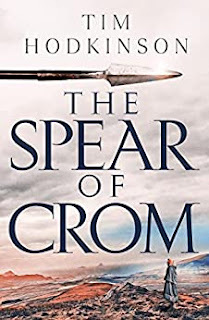
March 31, 2022
The Bear's Blade - Out on April 7!
Einar, son of Thorfinn the skull cleaver, sets sail on his 5th adventure on April 7. The e-book of The Bear's Blade will be available from all the usual outlets form that day, with the paperback edition to follow in July.
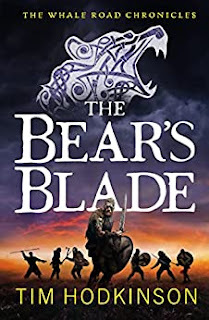
Einar must take back control of his destiny in this thrilling Viking adventure.
How do you defeat the undefeatable?935 AD, Norway. Recovering from horrendous injuries, Einar finds himself unable to fight. He is not strong enough to defeat his rival, Eirik, who has seized Orkney despite Einar being the rightful Jarl.
Eirik's men soon raid the Norwegian coast, led by a warrior called the Bear. Cruel and ferocious, the Bear possesses a legendary blade – one that gives him a skill in battle that cannot be matched. Such an extraordinary sword could be key to Einar's plans – but first he and the Wolf Coats must contend with the Bear himself.
Caught between old foes and new ones, Einar must use all his wits to survive. But is a man who cannot wield a sword capable of being a true Viking warrior?
Get your copy: https://www.amazon.co.uk/dp/B09GH567V1
December 17, 2020
The Yule Book Flood
I’ve written before about the Christmas traditions that stretch back to the Norse festival of Jól (Yule) and the downright scary Christmas demons like Krampus who haunt the Alpine regions. Iceland’s traditions are no less weird and wonderful.
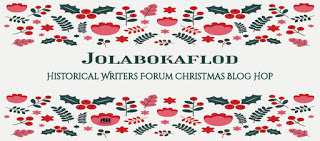
As readers will know, the main character of The Whale Road Chronicles, my series of historical novels set in the Viking age, is Einar Unnsson, an Icelander. Iceland has many Christmas– or Jól (Yule)- traditions. These range from the downright frightening, like the child-eating trolls Gryla and her lazy husband Leppaludi, or their monstrous Yule Cat (who makes an appearance in the Christmas Chronicles 2), to the irritating Yule Lads who come down from the mountains to deliver presents to good children while at the same time creating minor harassments like stealing milk, slamming doors or licking spoons.
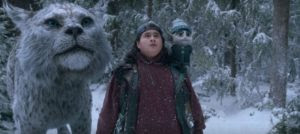 The Yule Cat in Christmas Chronicles 2
The Yule Cat in Christmas Chronicles 2
This “Yule Book Flood” goes back to the Second World War. Iceland was already a nation of avid readers and strict currency restrictions during WW2 limited the amount of imported gifts available. One thing that was less restricted was imported paper. This led to books becoming an affordable and massively popular Christmas gift and an annual “flood of books” still arrives in December to this day.
In honour of this tradition, The Historical Writers Forum Facebook group are running a December Blog Hop. As part of that, I’ll be giving away a copy of Odin’s Game, the first in the series of Einar’s adventures that make up The Whale Road Chronicles.
For a chance to win, like and share the Whale Road Chronicles Facebook Page .
For a chance to win another work of HF tomorrow, head on over to the next stop on the blog tour, at Selina Baker’s blog.
Here’s the Blurb:
Not everyone will survive, but who will conquer all in Odin's game?
AD 915.
In the Orkney Isles, a young woman flees her home to save the life of her unborn child. Eighteen years later, a witch foretells that evil from her past is reaching out again to threaten her son.
Outlawed from his home in Iceland, Einar Unnsson is thrown on the mercy of his Uncle, the infamous Jarl Thorfinn 'Skull Cleaver' of Orkney. He joins forces with a Norse-Irish princess and a company of wolfskin-clad warriors to become a player in a deadly game for control of the Irish sea, where warriors are the pawns of kings and Jarls and the powerful are themselves mere game pieces on the tafl board of the Gods.
Together they embark on a quest where Einar must fight unimaginable foes, forge new friendships, and discover what it truly means to be a warrior. As the clouds of war gather, betrayal follows betrayal and Einar realises the only person he can really trust is himself.
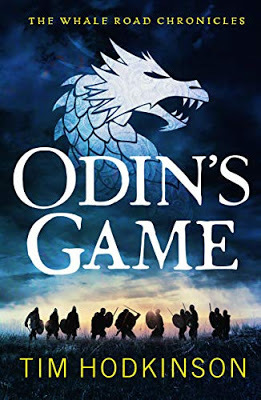
December 13, 2020
Win free books!
✒️ 4 Series Starters ✒️
One lucky #AriesChristmas winner will get to start FOUR new series!



